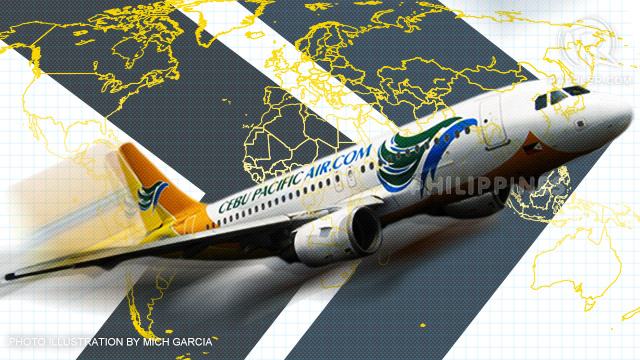SUMMARY
This is AI generated summarization, which may have errors. For context, always refer to the full article.

MANILA, Philippines (3rd UPDATE) – Dubai is Cebu Pacific’s first long-haul destination, the company announced Thursday, January 17, adding flights will begin on October 7, 2013.
This marks the first time a Philippine budget airline will offer a direct flight to a destination that is more than 4 hours away, or short-haul in industry jargon.
The Gokongwei-led airline will mount 7-a-week, 9-hour-long direct flights between Manila and Dubai. Cebu Pacific is currently the biggest budget carrier in the Philippines and is considered the first to adopt a low-cost model in Asia.
Unlike other budget carriers in the world that have expanded from short- to long-haul, Cebu Pacific is banking on the growing overseas Filipino workers (OFW) market in Dubai to keep the route vibrant. There are about 700,000 OFWs in Dubai, making the destination the 4th largest OFW population in any single area.
“Now our kababayans in Dubai can enjoy fares that are up to 40% loer than current offerings,” Cebu Pacific’s long-haul division head Alex Reyes said.
To launch the new route, Cebu Pacific announced that it is offering on sale over 3,000 seats, or about 4% of the total 80,000 seats in the first 100 days of the new route in October. For only P888 one-way excluding taxes and other fees, the seat sale is available from January 17 to 20, 2013 for travel from October 7, 2013 to January 15, 2014. That’s about under P13,000 all-in for a return flight.
OFW market
The price-sensitive market, which primarily consists of migrant worker traffic, works well with the budget airlines business model, Cebu Pacific CEO and president Lance Gokongwei said at the launch.
Aside from Dubai, many local airlines have been eyeing destinations, such as Saudi Arabia and United Arab Emirates in the Middle East, where 2.3 million Filipinos currently live and work.
According to the data from Philippine Overseas Employment Administration (POEA), the UAE ranks second to Saudi Arabia in terms of number of land based new hires and re-hires.
“Dubai is the largest long-haul market to and from the Philippines. IATA PaxIS data indicate more than 70% of passengers in this route take multiple stops and connecting flights because no home carrier offers a non-stop service,” said Reyes.
There is no Filipino carrier that is currently flying direct to Dubai or anywhere in the Middle East.
The direct Manila-Dubai route is currently serviced by Emirates, which currently operates a total flights of 14-a-week since it also “rents” via a code-share agreement the flight allocation awarded by the Philippine government to legacy carrier, Philippine Airlines (PAL).
Emirates has sought additional flight allocations during bilateral air negoations between the two goverments, while Cebu Pacific, a new entrant in the long-haul game, has aggressively sought new allocations, too.
Cebu Pacific’s new Manila-Dubai service comes from the additional 14-a-week allocation that both the governments have agreed upon in their recent 2012 bilateral air negotiations.
Airbus, with wifi
The airline will use an Airbus A330-300 aircraft, with a capacity of 436 seats and available wifi service.
Cebu Pacific previously announced that it will lease up to 8 Airbus A330-300 aircrafts for its long-haul operations. The airline will take delivery of two Airbus A330 aircraft this year and an additional two in 2014.
The A330 has a range of up to 11 hours, which means CEB can serve markets such as Australia, Middle East, parts of Europe and the US.
Gokongwei-led Cebu Pacific announced earlier in January its plans to launch a series of long-haul destinations in 2013.
A new entrant in the long-haul market, which PAL has dominated, Cebu Pacific has been pushing for seat entitlements in bilateral air negotiations.
Domestic market ‘oversaturated’
Going long haul, or flying to destinations over 4 hours away, has been considered the natural area of expansion for Philippine low-cost carriers (LCCs), given an oversaturated domestic market.
“As LCCs already control over 80% of the Philippine domestic market, I wouldn’t expect further increases in market penetration domestically. I think we are instead potentially in for a year in which we may see some consolidation in the Philippines domestic market,” Brendan Sobie, chief analyst at Centre for Aviation, said in a previous interview.
“As for the international market, there should be a further increase in the LCC penetration rate as several of the local LCCs continue to expand regionally in Asia, and as Cebu [Pacific], and possibly AirPhil, launch their new long-haul low-cost operations,” he added.
South Korea is currently the Philippines’ largest market. However, local carriers believe the Chinese market could eventually overtake South Korea due to China’s size and number of airport connections.
Other lucrative long-haul markets, like the United States and the European Union, remain closed to new or additional flights by Philippine carriers. Since 2008, the Civil Aviation Authority of the Philippines, which regulates and oversees the airline industry, have failed to comply with minimum international aviation safety standards set by the International Civil Aviation Organization.
The year 2012 marked Cebu Pacific’s aggressive expansion in terms of fleet and destinations.The airline opened 10 new domestic routes in 2012 and launched Bali as its 20th international destination. Flights will begin on March 16, 2013.
Cebu Pacific currently flies to 32 domestic destinations and 21 international destinations. – Rappler.com
Add a comment
How does this make you feel?
There are no comments yet. Add your comment to start the conversation.